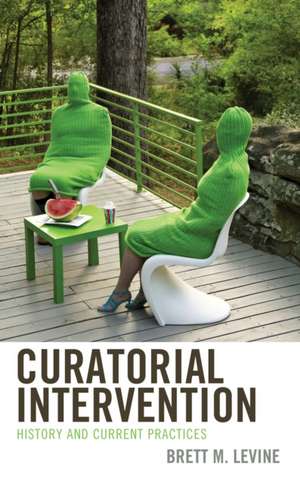Curatorial Intervention
Autor Brett M. Levineen Limba Engleză Paperback – 16 feb 2023
| Toate formatele și edițiile | Preț | Express |
|---|---|---|
| Paperback (1) | 309.98 lei 6-8 săpt. | |
| Rowman & Littlefield Publishers, Inc. – 16 feb 2023 | 309.98 lei 6-8 săpt. | |
| Hardback (1) | 613.37 lei 6-8 săpt. | |
| Rowman & Littlefield – 17 mai 2021 | 613.37 lei 6-8 săpt. |
Preț: 309.98 lei
Nou
Puncte Express: 465
Preț estimativ în valută:
59.31€ • 64.63$ • 49.98£
59.31€ • 64.63$ • 49.98£
Carte tipărită la comandă
Livrare economică 23 aprilie-07 mai
Preluare comenzi: 021 569.72.76
Specificații
ISBN-13: 9781538181409
ISBN-10: 1538181401
Pagini: 148
Dimensiuni: 152 x 229 x 8 mm
Greutate: 0.23 kg
Editura: Rowman & Littlefield Publishers, Inc.
ISBN-10: 1538181401
Pagini: 148
Dimensiuni: 152 x 229 x 8 mm
Greutate: 0.23 kg
Editura: Rowman & Littlefield Publishers, Inc.
Notă biografică
Brett M. Levine is a curator, writer, and editor who explores the intersections between intentionality, interventionality, and reception. Formerly the director of Lopdell House Gallery, Auckland, and team leader, collection programs at the Dowse Art Museum, Wellington, Levine¿s curatorial projects explore questions of representation, identity, and perception with an emphasis on installation, time-based media, and experimental practices. His writings have appeared in Art New Zealand, Object, Urbis, and Art Papers, as well as in monographs on Brad Buckley, and Ross T. Smith. Levine lives and works in Birmingham, Alabama
Descriere
Descriere de la o altă ediție sau format:
This book covers the history of intervention theory, initial research including interviews with thirty professional artists, curators, and administrators, working in Australia, New Zealand, and the United States with narratives that reflected both the prevalence of, and the inherent opacity within, curatorial intervention.
This book covers the history of intervention theory, initial research including interviews with thirty professional artists, curators, and administrators, working in Australia, New Zealand, and the United States with narratives that reflected both the prevalence of, and the inherent opacity within, curatorial intervention.
